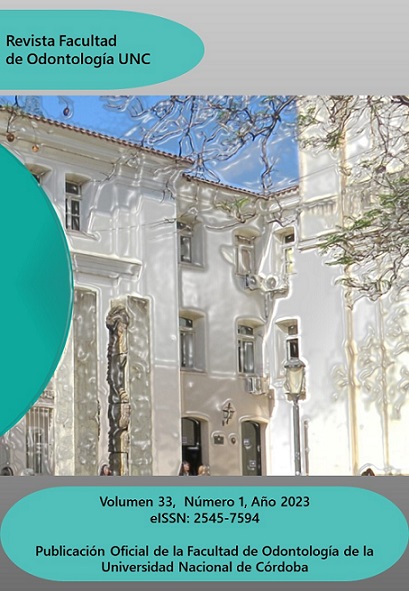Morphological changes of the jaw present in unilateral chewing patients
Keywords:
Temporomandibular Joint, Masticatory Cycle, Parafunction, Unilateral MasticationAbstract
Aim: To determine the morphological changes of the mandibular anatomical structures in relation to the masticatory pattern of patients attending the Craniomandibular Disorders Research Unit (Unicram) of the Faculty of Dentistry of the University of Carabobo, Valencia, Venezuela. Methods: Descriptive, non-experimental, cross-sectional study, whose sample consisted of 39 patients from 20 to 30 years old who attended the Craniomandibular Disorders Research Unit (UNICRAM) of the Faculty of Dentistry of the University of Carabobo, in a period of six months from March to September of the year 2021, selected based on the masticatory pattern of the patients who attending the temporomandibular disorders unit. It was verified if the patient is a unilateral chewer by giving him a piece of gum and asking him to chew it for 2 minutes, which, his chewing preference side could be observed, verifying the effectiveness of the AFM. With a panoramic radiograph, measurements were made through the Simoes Symmetry Panorogram. Results: The patients with the right working side highlighted an increase in the height and width of the condyle on the working side, while the balance side showed an increase in the width and height of the mandibular ramus; and in patients with the left working side, a decrease in the height and width of the condyle on the working side was found. Conclusions: Those patients who have a preference for unilateral chewing, develop chewing on that side. The jaw may undergo volume enlargement and ossification by mechanical stimulation
Downloads
References
Bourdiol P, Hennequin M, Peyron MA, Woda A. Masticatory Adaptation to Occlusal Changes. Front Physiol. 2020 Apr 3; 11:263. doi: 10.3389/fphys.2020.00263. PMID: 32317982; PMCID: PMC7147355.
Kato Y, Kikutani T, Sagawa K, Tamura F. Association between masticatory movement and oral and physical function in healthy older women. J Prosthodont Res. 2021 Nov 18. doi: 10.2186/jpr.JPR_D_20_00285. Epub ahead of print. PMID: 34789608.
Lomas J, Gurgenci T, Jackson C, Campbell D. Temporomandibular dysfunction. Aust J Gen Pract. 2018 Apr;47(4):212-215. doi: 10.31128/AFP-10-17-4375. PMID: 29621862.
Ramos VF, Silva AF, Picinato-Pirola M. Masticatory function in elderly compared to young adults. Codas. 2021 Oct 25; 34(1):e20200364. doi: 10.1590/2317-1782/20212020364. PMID: 34705926.
Van Bellinghen X, Idoux-Gillet Y, Pugliano M, Strub M, Bornert F, Clauss F, Schwinté P, Keller L, Benkirane-Jessel N, Kuchler-Bopp S, Lutz JC, Fioretti F. Temporomandibular Joint Regenerative Medicine. Int J Mol Sci. 2018 Feb 2; 19(2):446. doi: 10.3390/ijms19020446. PMID: 29393880; PMCID: PMC5855668.
Haralur SB, Majeed MI, Chaturvedi S, Alqahtani NM, Alfarsi M. Association between preferred chewing side and dynamic occlusal parameters. J Int Med Res. 2019 May; 47(5):1908-1915. doi: 10.1177/0300060519827165. Epub 2019 Feb 14. PMID: 30764682; PMCID: PMC6567747.
López-Cedrún J, Santana-Mora U, Pombo M, Pérez Del Palomar A, Alonso De la Peña V, Mora MJ, Santana U. Jawbiodynamic data for 24 patientswithchronic unilateral temporomandibular disorder. Sci Data. 2017 Nov 7; 4:170168. doi: 10.1038/sdata.2017.168. PMID: 29112190; PMCID: PMC5674825
Simoes W. Ortopedia Funcional de Los Maxilares a Traves de La Rehabilitacion Neuro Oclusal. 3ra Edición. Sao Paulo, Brasil: Artes Médicas; 2004
Pasinato F, Oliveira AG, Santos-Couto-Paz CC, Zeredo JL, Bolzan GP, Macedo SB, Corrêa EC. Study of the kinematic variables of unilateral and habitual mastication of healthy individuals. Codas. 2017 Mar 30; 29(2):e20160074. Portuguese, English. doi: 10.1590/2317-1782/20172016074. PMID: 28380201.
Sella-Tunis T, Pokhojaev A, Sarig R, O'Higgins P, May H. Human mandibular shape is associated with masticatory muscle force. Sci Rep. 2018 Apr 16; 8(1):6042. doi: 10.1038/s41598-018-24293-3. PMID: 29662127; PMCID: PMC5902585.
Koç, N., &Çağırankaya, L. B. (2019). Investigation of the determinants of the mandibular cortical morphology. Dental and medical problems, 56(1), 21–25. https://doi.org/10.17219/dmp/102262
Chen H, Liu Z, Hu X, Wu B, Gu Y. Comparison of mandibular cross-sectional morphology between Class I and Class II subjects with different vertical patterns: based on CBCT images and statistical shape analysis. BMC Oral Health. 2021 May 5; 21(1):238. doi: 10.1186/s12903-021-01591-3. PMID: 33952217; PMCID: PMC8097981.
Casanova-Sarmiento JA, Arriola-Guillén LE, Ruíz-Mora GA, Rodríguez-Cárdenas YA, Aliaga-Del Castillo A. Comparison of anterior mandibular alveolar thickness and height in young adults with different sagittal and vertical skeletal relationships: A CBCT Study. IntOrthod. 2020 Mar; 18(1):79-88. doi: 10.1016/j.ortho.2019.10.001. Epub 2019 Nov 14. PMID: 31735681.
Oh, H., Knigge, R., Hardin, A., Sherwood, R., Duren, D., Valiathan, M., Leary, E., & McNulty, K. (2019). Predicting adult facial type from mandibular landmark data at young ages. Orthodontics & craniofacial research, 22 Suppl 1(Suppl 1), 154–162. https://doi.org/10.1111/ocr.12296
Hasebe A, Yamaguchi T, Nakawaki T, Hikita Y, Katayama K, Maki K. Comparison of condylar size among different anteroposterior and vertical skeletal patterns using cone-beam computed tomography. Angle Orthod. 2019 Mar; 89(2):306-311. doi: 10.2319/032518-229.1. Epub 2018 Nov 26. PMID: 30475648; PMCID: PMC8120880
Published
Issue
Section
License

This work is licensed under a Creative Commons Attribution-NonCommercial-ShareAlike 4.0 International License.
Aquellos autores/as que tengan publicaciones con esta revista, aceptan los términos siguientes:
- Los autores/as conservarán sus derechos de autor y garantizarán a la revista el derecho de primera publicación de su obra, el cuál estará simultáneamente sujeto a la Licencia de reconocimiento de Creative Commons que permite a terceros:
- Compartir — copiar y redistribuir el material en cualquier medio o formato
- La licenciante no puede revocar estas libertades en tanto usted siga los términos de la licencia
- Los autores/as podrán adoptar otros acuerdos de licencia no exclusiva de distribución de la versión de la obra publicada (p. ej.: depositarla en un archivo telemático institucional o publicarla en un volumen monográfico) siempre que se indique la publicación inicial en esta revista.
- Se permite y recomienda a los autores/as difundir su obra a través de Internet (p. ej.: en archivos telemáticos institucionales o en su página web) después del su publicación en la revista, lo cual puede producir intercambios interesantes y aumentar las citas de la obra publicada. (Véase El efecto del acceso abierto).

